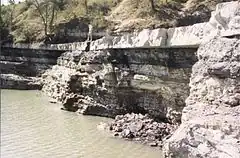Johnson Formation
The Johnson Formation (or Johnson Limestone) is a thick geologic formation of soft shale with thin, resistant beds of chalkier mudstone and limestone in Nebraska, Kansas, and Oklahoma rarely exposed outside of road cuts. It preserves fossils dating back to the late-Carboniferous period.[1]
| Johnson Formation | |
|---|---|
| Stratigraphic range: Carboniferous[1] | |
 Head cut of Johnson Shale in the Tuttle Creek Lake spillway freshly exposed by the 1993 flood, showing unweathered coloration. (capped by the bright Glenrock limestone member of the Red Eagle Formation) | |
| Type | Formation |
| Underlies | Red Eagle Formation |
| Overlies | Foraker Formation |
| Lithology | |
| Primary | Shale |
| Other | resistant beds of argillaceous mudstone to well-laminated limestones[2] |
| Location | |
| Region | Midcontinent (Nebraska, Kansas, Oklahoma)[2] |
| Country | United States |
| Type section | |
| Named for | Johnson, Oklahoma[2] |
See also
References
- Robert S. Sawin, Ronald R. West, Evan K. Franseen, W. Lynn Watney (January 2006). "Carboniferous-Permian Boundary in Kansas, Midcontinent, U.S.A". Current Research in Earth Sciences. 252 (1).
... the Carboniferous-Permian boundary in Kansas can now be confidently defined. Based [on fossil changes, the] boundary in Kansas can be placed at the base of the Bennett Shale Member of the Red Eagle Limestone [which the Johnson underlies].
{{cite journal}}: CS1 maint: multiple names: authors list (link) - Jewett, John M. (1941). The Geology of Riley and Geary Counties, Kansas, Kansas Geological Survey Bulletin 39. University of Kansas Publications, State Geological Survey of Kansas.
This article is issued from Wikipedia. The text is licensed under Creative Commons - Attribution - Sharealike. Additional terms may apply for the media files.